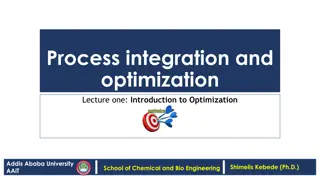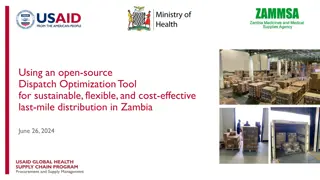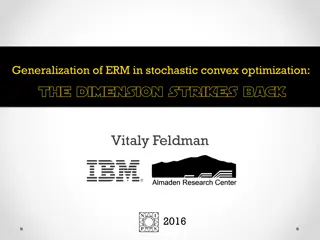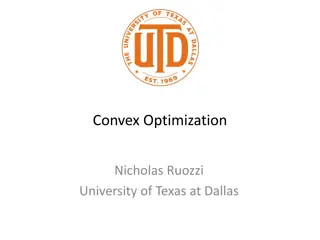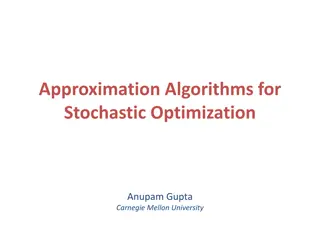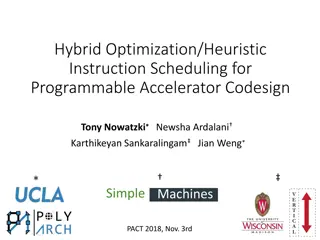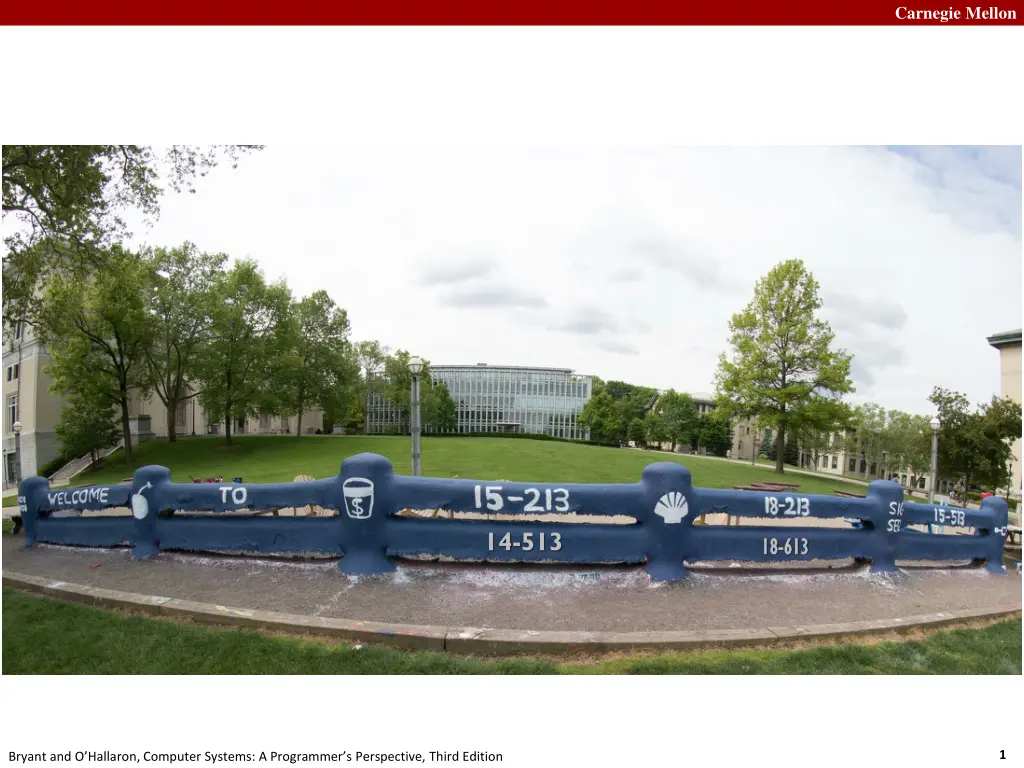
Carnegie Mellon Computer Systems Optimization Insights
"Explore the world of computer systems optimization with insights from Carnegie Mellon University. Learn about the importance of code optimization, performance realities, and compiler efficiency in maximizing program efficiency and speed. Discover useful optimizations and the historical impact of Admiral Grace Hopper's pioneering work in compiler technology."
Download Presentation

Please find below an Image/Link to download the presentation.
The content on the website is provided AS IS for your information and personal use only. It may not be sold, licensed, or shared on other websites without obtaining consent from the author. If you encounter any issues during the download, it is possible that the publisher has removed the file from their server.
You are allowed to download the files provided on this website for personal or commercial use, subject to the condition that they are used lawfully. All files are the property of their respective owners.
The content on the website is provided AS IS for your information and personal use only. It may not be sold, licensed, or shared on other websites without obtaining consent from the author.
E N D
Presentation Transcript
Carnegie Mellon 14-513 18 18- -613 613 1 Bryant and O Hallaron, Computer Systems: A Programmer s Perspective, Third Edition
Carnegie Mellon Code Optimization 18-213/18-613: Introduction to Computer Systems 9th Lecture, May 29th, 2025 2 Bryant and O Hallaron, Computer Systems: A Programmer s Perspective, Third Edition
Carnegie Mellon Performance Realities There s more to performance than asymptotic complexity Constant factors matter too! Easily see 10:1 performance range depending on how code is written Must optimize at multiple levels: algorithm, data representations, procedures, and loops Must understand system to optimize performance How programs are compiled and executed How modern processors + memory systems operate How to measure program performance and identify bottlenecks How to improve performance without destroying code modularity and generality 3 Bryant and O Hallaron, Computer Systems: A Programmer s Perspective, Third Edition
Carnegie Mellon Optimizing Compilers Provide efficient mapping of program to machine register allocation code selection and ordering (scheduling) dead code elimination eliminating minor inefficiencies Don t (usually) improve asymptotic efficiency up to programmer to select best overall algorithm big-O savings are (often) more important than constant factors but constant factors also matter Have difficulty overcoming optimization blockers potential procedure side-effects potential memory aliasing 4 Bryant and O Hallaron, Computer Systems: A Programmer s Perspective, Third Edition
Carnegie Mellon Today Generally Useful Optimizations Code motion/precomputation Strength reduction Sharing of common subexpressions Example: Bubblesort CSAPP 5.1 Optimization Blockers Procedure calls Memory aliasing CSAPP 5.1 Exploiting Instruction-Level Parallelism CSAPP 5.2-5.10 CSAPP 5.11 Dealing with Conditionals 5 Bryant and O Hallaron, Computer Systems: A Programmer s Perspective, Third Edition
Carnegie Mellon Rear Admiral Grace Hopper (1906-1992) Invented first compiler in 1951 (technically it was a linker) Coined compiler (and bug ) Compiled for Harvard Mark I Eventually led to COBOL (which ran the world for years) I decided data processors ought to be able to write their programs in English, and the computers would translate them into machine code 6 Bryant and O Hallaron, Computer Systems: A Programmer s Perspective, Third Edition
Carnegie Mellon Generally Useful Optimizations Optimizations that you or the compiler should do regardless of processor / compiler Code Motion Reduce frequency with which computation performed If it will always produce same result Especially moving code out of loop void set_row(double *a, double *b, long i, long n) { long j; for (j = 0; j < n; j++) a[n*i+j] = b[j]; } long j; int ni = n*i; for (j = 0; j < n; j++) a[ni+j] = b[j]; 7 Bryant and O Hallaron, Computer Systems: A Programmer s Perspective, Third Edition
Carnegie Mellon Compiler-Generated Code Motion (-O1) void set_row(double *a, double *b, long i, long n) { long j; for (j = 0; j < n; j++) a[n*i+j] = b[j]; } long j; long ni = n*i; double *rowp = a+ni; for (j = 0; j < n; j++) *rowp++ = b[j]; set_row: .L3: .L1: testq jle imulq leaq movl movsd movsd addq cmpq jne rep ; ret %rcx, %rcx .L1 %rcx, %rdx (%rdi,%rdx,8), %rdx $0, %eax (%rsi,%rax,8), %xmm0 %xmm0, (%rdx,%rax,8) $1, %rax %rcx, %rax .L3 # Test n # If <= 0, goto done # ni = n*i # rowp = A + ni*8 # j = 0 # loop: # t = b[j] # M[A+ni*8 + j*8] = t # j++ # j:n # if !=, goto loop # done: 8 Bryant and O Hallaron, Computer Systems: A Programmer s Perspective, Third Edition
Carnegie Mellon Strength Reduction Replace costly operation with simpler one Shift, add instead of multiply or divide 16*x x << 4 Utility is machine dependent Depends on cost of multiply or divide instruction Intel Nehalem: integer multiply takes 3 CPU cycles, add is 1 cycle1 Recognize sequence of products int ni = 0; for (i = 0; i < n; i++) { for (j = 0; j < n; j++) a[ni + j] = b[j]; ni += n; } for (i = 0; i < n; i++) { int ni = n*i; for (j = 0; j < n; j++) a[ni + j] = b[j]; } 1https://www.agner.org/optimize/instruction_tables.pdf 9 Bryant and O Hallaron, Computer Systems: A Programmer s Perspective, Third Edition
Carnegie Mellon Share Common Subexpressions Reuse portions of expressions GCC will do this with O1 /* Sum neighbors of i,j */ up = val[(i-1)*n + j ]; down = val[(i+1)*n + j ]; left = val[i*n + j-1]; right = val[i*n + j+1]; sum = up + down + left + right; long inj = i*n + j; up = val[inj - n]; down = val[inj + n]; left = val[inj - 1]; right = val[inj + 1]; sum = up + down + left + right; 3 multiplications: i*n, (i 1)*n, (i+1)*n 1 multiplication: i*n leaq 1(%rsi), %rax # i+1 leaq -1(%rsi), %r8 # i-1 imulq %rcx, %rsi # i*n imulq %rcx, %rax # (i+1)*n imulq %rcx, %r8 # (i-1)*n addq %rdx, %rsi # i*n+j addq %rdx, %rax # (i+1)*n+j addq %rdx, %r8 # (i-1)*n+j ... imulq addq movq subq leaq ... %rcx, %rsi # i*n %rdx, %rsi # i*n+j %rsi, %rax # i*n+j %rcx, %rax # i*n+j-n (%rsi,%rcx), %rcx # i*n+j+n 10 Bryant and O Hallaron, Computer Systems: A Programmer s Perspective, Third Edition
Carnegie Mellon Optimization Example: Bubblesort Bubblesort program that sorts an array A that is allocated in static storage: an element of A requires four bytes elements of A are numbered 1 through n (n is a variable) A[j] is in location &A+4*(j-1) for (i = n-1; i >= 1; i--) { for (j = 1; j <= i; j++) if (A[j] > A[j+1]) { temp = A[j]; A[j] = A[j+1]; A[j+1] = temp; } } 11 Bryant and O Hallaron, Computer Systems: A Programmer s Perspective, Third Edition
Carnegie Mellon Translated (Pseudo) Code i := n-1 L5: if i<1 goto L1 j := 1 L4: if j>i goto L2 t1 := j-1 t2 := 4*t1 t3 := A[t2] // A[j] t4 := j+1 t5 := t4-1 t6 := 4*t5 t7 := A[t6] // A[j+1] if t3<=t7 goto L3 t8 := j-1 t9 := 4*t8 temp := A[t9] // temp:=A[j] t10 := j+1 t11:= t10-1 t12 := 4*t11 t13 := A[t12] // A[j+1] t14 := j-1 t15 := 4*t14 A[t15] := t13 // A[j]:=A[j+1] t16 := j+1 t17 := t16-1 t18 := 4*t17 A[t18]:=temp // A[j+1]:=temp L3: j := j+1 goto L4 L2: i := i-1 goto L5 L1: for (i = n-1; i >= 1; i--) { for (j = 1; j <= i; j++) if (A[j] > A[j+1]) { temp = A[j]; A[j] = A[j+1]; A[j+1] = temp; } } Instructions 29 in outer loop 25 in inner loop 12 Bryant and O Hallaron, Computer Systems: A Programmer s Perspective, Third Edition
Carnegie Mellon Redundancy in Address Calculation i := n-1 L5: if i<1 goto L1 j := 1 L4: if j>i goto L2 t1 := j-1 t2 := 4*t1 t3 := A[t2] // A[j] t4 := j+1 t5 := t4-1 t6 := 4*t5 t7 := A[t6] // A[j+1] if t3<=t7 goto L3 t8 :=j-1 t9 := 4*t8 temp := A[t9] // temp:=A[j] t10 := j+1 t11:= t10-1 t12 := 4*t11 t13 := A[t12] // A[j+1] t14 := j-1 t15 := 4*t14 A[t15] := t13 // A[j]:=A[j+1] t16 := j+1 t17 := t16-1 t18 := 4*t17 A[t18]:=temp // A[j+1]:=temp L3: j := j+1 goto L4 L2: i := i-1 goto L5 L1: 13 Bryant and O Hallaron, Computer Systems: A Programmer s Perspective, Third Edition
Carnegie Mellon Redundancy Removed t8 :=j-1 t9 := 4*t8 temp := A[t9] // temp:=A[j] t12 := 4*j t13 := A[t12] // A[j+1] A[t9]:= t13 // A[j]:=A[j+1] A[t12]:=temp // A[j+1]:=temp L3: j := j+1 goto L4 L2: i := i-1 goto L5 L1: i := n-1 L5: if i<1 goto L1 j := 1 L4: if j>i goto L2 t1 := j-1 t2 := 4*t1 t3 := A[t2] //A[j] t6 := 4*j t7 := A[t6] // A[j+1] if t3<=t7 goto L3 Instructions 20 in outer loop 16 in inner loop 14 Bryant and O Hallaron, Computer Systems: A Programmer s Perspective, Third Edition
Carnegie Mellon More Redundancy i := n-1 L5: if i<1 goto L1 j := 1 L4: if j>i goto L2 t1 := j-1 t2 := 4*t1 t3 := A[t2] // A[j] t6 := 4*j t7 := A[t6] // A[j+1] if t3<=t7 goto L3 t8 :=j-1 t9 := 4*t8 temp := A[t9] // temp:=A[j] t12 := 4*j t13 := A[t12] // A[j+1] A[t9]:= t13 // A[j]:=A[j+1] A[t12]:=temp // A[j+1]:=temp L3: j := j+1 goto L4 L2: i := i-1 goto L5 L1: 15 Bryant and O Hallaron, Computer Systems: A Programmer s Perspective, Third Edition
Carnegie Mellon Redundancy Removed i := n-1 L5: if i<1 goto L1 j := 1 L4: if j>i goto L2 t1 := j-1 t2 := 4*t1 t3 := A[t2] // old_A[j] t6 := 4*j t7 := A[t6] // A[j+1] if t3<=t7 goto L3 A[t2] := t7 // A[j]:=A[j+1] A[t6] := t3 // A[j+1]:=old_A[j] L3: j := j+1 goto L4 L2: i := i-1 goto L5 L1: Instructions 15 in outer loop 11 in inner loop 16 Bryant and O Hallaron, Computer Systems: A Programmer s Perspective, Third Edition
Carnegie Mellon Redundancy in Loops i := n-1 L5: if i<1 goto L1 j := 1 L4: if j>i goto L2 t1 := j-1 t2 := 4*t1 t3 := A[t2] //A[j] t6 := 4*j t7 := A[t6] // A[j+1] if t3<=t7 goto L3 A[t2] := t7 A[t6] := t3 L3: j := j+1 goto L4 L2: i := i-1 goto L5 L1: 17 Bryant and O Hallaron, Computer Systems: A Programmer s Perspective, Third Edition
Carnegie Mellon Redundancy Eliminated i := n-1 L5: if i<1 goto L1 j := 1 L4: if j>i goto L2 t1 := j-1 t2 := 4*t1 t3 := A[t2] //A[j] t6 := 4*j t7 := A[t6] // A[j+1] if t3<=t7 goto L3 i := n-1 L5: if i<1 goto L1 t2 := 0 t6 := 4 t19 := 4*i L4: if t6>t19 goto L2 t3 := A[t2] t7 := A[t6] if t3<=t7 goto L3 A[t2] := t7 A[t6] := t3 L3: t2 := t2+4 t6 := t6+4 goto L4 L2: i := i-1 goto L5 L1: A[t2] := t7 A[t6] := t3 L3: j := j+1 goto L4 L2: i := i-1 goto L5 L1: 18 Bryant and O Hallaron, Computer Systems: A Programmer s Perspective, Third Edition
Carnegie Mellon Final Pseudo Code (after strength reduction) i := n-1 L5: if i<1 goto L1 t2 := 0 t6 := 4 t19 := i << 2 L4: if t6>t19 goto L2 t3 := A[t2] t7 := A[t6] if t3<=t7 goto L3 Instructions Before Optimizations 29 in outer loop 25 in inner loop Instructions After Optimizations 15 in outer loop 9 in inner loop A[t2] := t7 A[t6] := t3 L3: t2 := t2+4 t6 := t6+4 goto L4 L2: i := i-1 goto L5 L1: These were Machine-Independent Optimizations. Will be followed by Machine-Dependent Optimizations, including allocating temporaries to registers, converting to assembly code 19 Bryant and O Hallaron, Computer Systems: A Programmer s Perspective, Third Edition
Carnegie Mellon Today Generally Useful Optimizations Code motion/precomputation Strength reduction Sharing of common subexpressions Example: Bubblesort Optimization Blockers Procedure calls Memory aliasing Exploiting Instruction-Level Parallelism Dealing with Conditionals 20 Bryant and O Hallaron, Computer Systems: A Programmer s Perspective, Third Edition
Carnegie Mellon John Backus (1924-2007) Led team at IBM invented the first commercially available compiler in 1957 Compiled FORTRAN code for the IBM 704 computer FORTRAN still in use today for high performance code Much of my work has come from being lazy. I didn't like writing programs, and so, when I was working on the IBM 701, I started work on a programming system to make it easier to write programs 21 Bryant and O Hallaron, Computer Systems: A Programmer s Perspective, Third Edition
Carnegie Mellon Limitations of Optimizing Compilers Operate under fundamental constraint Must not cause any change in program behavior Often prevents optimizations that affect only edge case behavior Behavior obvious to the programmer is not obvious to compiler e.g., Data range may be more limited than types suggest (short vs. int) Most analysis is only within a procedure Whole-program analysis is usually too expensive Sometimes compiler does interprocedural analysis within a file (new GCC) Most analysis is based only on static information Compiler has difficulty anticipating run-time inputs When in doubt, the compiler must be conservative 22 Bryant and O Hallaron, Computer Systems: A Programmer s Perspective, Third Edition
Carnegie Mellon Optimization Blocker #1: Procedure Calls Procedure to Convert String to Lower Case void lower1(char *s) { size_t i; for (i = 0; i < strlen(s); i++) if (s[i] >= 'A' && s[i] <= 'Z') s[i] -= ('A' - 'a'); } Extracted from 213 lab submissions 23 Bryant and O Hallaron, Computer Systems: A Programmer s Perspective, Third Edition
Carnegie Mellon Lower Case Conversion Performance 250 200 CPU seconds 150 100 50 lower1 0 0 50000 100000 150000 200000 250000 300000 350000 400000 450000 500000 String length Time quadruples when double string length Quadratic performance 24 Bryant and O Hallaron, Computer Systems: A Programmer s Perspective, Third Edition
Carnegie Mellon Calling Strlen /* My version of strlen */ size_t strlen(const char *s) { size_t length = 0; while (*s != '\0') { s++; length++; } return length; } void lower1(char *s) { size_t i; for (i = 0; i < strlen(s); i++) if (s[i] >= 'A' && s[i] <= 'Z') s[i] -= ('A' - 'a'); } Strlen performance Only way to determine length of string is to scan its entire length, looking for null character. Overall performance, string of length N N calls to strlen (called every time through the loop) Require times N, N-1, N-2, , 1 Overall O(N2) performance 25 Bryant and O Hallaron, Computer Systems: A Programmer s Perspective, Third Edition
Carnegie Mellon Improving Performance void lower2(char *s) { size_t i; size_t len = strlen(s); for (i = 0; i < len; i++) if (s[i] >= 'A' && s[i] <= 'Z') s[i] -= ('A' - 'a'); } Move call to strlen outside of loop Legal since result does not change from one iteration to another Form of code motion 26 Bryant and O Hallaron, Computer Systems: A Programmer s Perspective, Third Edition
Carnegie Mellon Lower Case Conversion Performance 250 200 CPU seconds 150 lower1 100 50 lower2 0 0 50000 100000 150000 200000 250000 300000 350000 400000 450000 500000 String length Time doubles when double string length Linear performance of lower2 27 Bryant and O Hallaron, Computer Systems: A Programmer s Perspective, Third Edition
Carnegie Mellon Optimization Blocker: Procedure Calls Why couldn t compiler move strlen out of inner loop? Procedure may have side effects Alters global state each time called Function may not return same value for given arguments Depends on other parts of global state Procedure lower1 could interact with strlen Warning: Compiler may treat procedure call as a black box Weak optimizations near them /* Alternative strlen */ size_t lencnt = 0; size_t strlen(const char *s) { size_t length = 0; while (*s != '\0') { s++; length++; } lencnt += length; return length; } Remedies: Use of inline functions GCC does this with O1 Within single file Do your own code motion 28 Bryant and O Hallaron, Computer Systems: A Programmer s Perspective, Third Edition
Carnegie Mellon Optimization Blocker #2: Memory Aliasing /* Sum rows of n X n matrix a and store in vector b */ void sum_rows1(double *a, double *b, long n) { long i, j; for (i = 0; i < n; i++) { b[i] = 0; for (j = 0; j < n; j++) b[i] += a[i*n + j]; } } # sum_rows1 inner loop .L4: movsd (%rsi,%rax,8), %xmm0 addsd (%rdi), %xmm0 movsd %xmm0, (%rsi,%rax,8) addq $8, %rdi cmpq %rcx, %rdi jne .L4 # FP load # FP add # FP store Code updates b[i] on every iteration Why couldn t compiler optimize this away? 29 Bryant and O Hallaron, Computer Systems: A Programmer s Perspective, Third Edition
Carnegie Mellon Memory Aliasing /* Sum rows is of n X n matrix a and store in vector b */ void sum_rows1(double *a, double *b, long n) { long i, j; for (i = 0; i < n; i++) { b[i] = 0; for (j = 0; j < n; j++) b[i] += a[i*n + j]; } } Value of B: double A[9] = { 0, 1, 2, 4, 8, 16, 32, 64, 128}; double A[9] = { 0, 1, 2, { 0, 1, 2, { 0, 1, 2, { 0, 1, 2, { 0, 1, 2, { 0, 1, 2, { 0, 1, 2, { 0, 1, 2, { 0, 1, 2, { 0, 1, 2, double A[9] = double A[9] = double A[9] = double A[9] = double A[9] = double A[9] = double A[9] = double A[9] = double A[9] = double A[9] = { 0, 1, 2, 0, 8, 16}, 1, 8, 16}, 3, 8, 16}, 3, 0, 16}, 3, 3, 16}, 3, 6, 16}, 3, 22, 16}, 3, 22, 0}, 3, 22, 32}, 3, 22, 96}, 3, 22, 224, double A[9] = { 0, 1, 2, 0, 8, 16}, 32, 64, 128}; 32, 64, 128}; 32, 64, 128}; 32, 64, 128}; 32, 64, 128}; 32, 64, 128}; 32, 64, 128}; 32, 64, 128}; 32, 64, 128}; 32, 64, 128}; 32, 64, 128}; 32, 64, 128}; init: [4, 8, 16] i = 0: [3, 8, 16] i = 1: [3, 22, 16] double B[3] = A+3; i = 2: [3, 22, 224] sum_rows1(A, B, 3); Code updates b[i] on every iteration Must consider possibility that these updates will affect program behavior 30 Bryant and O Hallaron, Computer Systems: A Programmer s Perspective, Third Edition
Carnegie Mellon Removing Aliasing /* Sum rows is of n X n matrix a and store in vector b */ void sum_rows2(double *a, double *b, long n) { long i, j; for (i = 0; i < n; i++) { double val = 0; for (j = 0; j < n; j++) val += a[i*n + j]; b[i] = val; } } # sum_rows2 inner loop .L10: addsd (%rdi), %xmm0 addq $8, %rdi cmpq %rax, %rdi jne .L10 # FP load + add No need to store intermediate results 31 Bryant and O Hallaron, Computer Systems: A Programmer s Perspective, Third Edition
Carnegie Mellon Optimization Blocker: Memory Aliasing Aliasing Two different memory references specify single location Easy to have happen in C Since allowed to do address arithmetic Direct access to storage structures Get in habit of introducing local variables Accumulating within loops Your way of telling compiler not to check for aliasing 32 Bryant and O Hallaron, Computer Systems: A Programmer s Perspective, Third Edition
Carnegie Mellon Today Generally Useful Optimizations Code motion/precomputation Strength reduction Sharing of common subexpressions Example: Bubblesort Optimization Blockers Procedure calls Memory aliasing Exploiting Instruction-Level Parallelism Dealing with Conditionals 33 Bryant and O Hallaron, Computer Systems: A Programmer s Perspective, Third Edition
Carnegie Mellon Fran Allen (1932-2020) Pioneer of many optimizing compilation techniques Wrote a paper simply called Program Optimization in 1966 This paper introduced the use of graph-theoretic structures to encode program content in order to automatically and efficiently derive relationships and identify opportunities for optimization First woman to win the ACM Turing Award (the Nobel Prize of Computer Science ), in 2006 34 Bryant and O Hallaron, Computer Systems: A Programmer s Perspective, Third Edition
Carnegie Mellon Exploiting Instruction-Level Parallelism Need general understanding of modern processor design Hardware can execute multiple instructions in parallel Performance limited by data dependencies Simple transformations can cause big speedups Compilers often cannot make these transformations Lack of associativity and distributivity in floating-point arithmetic 35 Bryant and O Hallaron, Computer Systems: A Programmer s Perspective, Third Edition
Carnegie Mellon Benchmark Example: Data Type for Vectors /* data structure for vectors */ typedef struct{ size_t len; data_t *data; } vec; len data 1 len-1 0 /* retrieve vector element and store at val */ int get_vec_element (*vec v, size_t idx, data_t *val) { if (idx >= v->len) return 0; *val = v->data[idx]; return 1; } Data Types Use different declarations for data_t int long float double 36 Bryant and O Hallaron, Computer Systems: A Programmer s Perspective, Third Edition
Carnegie Mellon Benchmark Computation void combine1(vec_ptr v, data_t *dest) { long int i; *dest = IDENT; for (i = 0; i < vec_length(v); i++) { data_t val; get_vec_element(v, i, &val); *dest = *dest OP val; } } Compute sum or product of vector elements Data Types Use different declarations for data_t int long float double Operations Use different definitions of OP and IDENT +/0 */1 37 Bryant and O Hallaron, Computer Systems: A Programmer s Perspective, Third Edition
Carnegie Mellon Cycles Per Element (CPE) Convenient way to express performance of program that operates on vectors or lists Length = n In our case: CPE = cycles per OP Cycles = CPE*n + Overhead CPE is slope of line 2500 2000 psum1 Slope = 9.0 1500 Cycles 1000 psum2 Slope = 6.0 500 0 0 50 100 150 200 Elements 38 Bryant and O Hallaron, Computer Systems: A Programmer s Perspective, Third Edition
Carnegie Mellon Benchmark Performance void combine1(vec_ptr v, data_t *dest) { long int i; *dest = IDENT; for (i = 0; i < vec_length(v); i++) { data_t val; get_vec_element(v, i, &val); *dest = *dest OP val; } } Compute sum or product of vector elements Method Integer Double FP Operation Add Mult Add Mult Combine1 unoptimized 22.68 20.02 19.98 20.18 Combine1 O1 10.12 10.12 10.17 11.14 Combine1 O3 4.5 4.5 6 7.8 Results in CPE (cycles per element) 39 Bryant and O Hallaron, Computer Systems: A Programmer s Perspective, Third Edition
Carnegie Mellon Basic Optimizations void combine4(vec_ptr v, data_t *dest) { long i; long length = vec_length(v); data_t *d = get_vec_start(v); data_t t = IDENT; for (i = 0; i < length; i++) t = t OP d[i]; *dest = t; } Move vec_length out of loop Avoid bounds check on each cycle Accumulate in temporary 40 Bryant and O Hallaron, Computer Systems: A Programmer s Perspective, Third Edition
Carnegie Mellon Effect of Basic Optimizations void combine4(vec_ptr v, data_t *dest) { long i; long length = vec_length(v); data_t *d = get_vec_start(v); data_t t = IDENT; for (i = 0; i < length; i++) t = t OP d[i]; *dest = t; } Method Integer Double FP Operation Add Mult Add Mult Combine1 O1 10.12 10.12 10.17 11.14 Combine4 1.27 3.01 3.01 5.01 Eliminates sources of overhead in loop 41 Bryant and O Hallaron, Computer Systems: A Programmer s Perspective, Third Edition
Carnegie Mellon Modern CPU Design Instruction Control Address Fetch Control Retirement Unit Register File Instruction Cache Instructions Instruction Decode Operations Register Updates Prediction OK? Functional Branch Arith Arith Arith Load Store Units Operation Results Addr. Addr. Data Data Data Cache Execution 42 Bryant and O Hallaron, Computer Systems: A Programmer s Perspective, Third Edition
Carnegie Mellon Superscalar Processor Definition: A superscalar processor can issue and execute multiple instructions in one cycle. The instructions are retrieved from a sequential instruction stream and are usually scheduled dynamically. Benefit: without programming effort, superscalar processor can take advantage of the instruction level parallelism that most programs have. Most CPUs are superscalar. Intel: since Pentium (1993) 43 Bryant and O Hallaron, Computer Systems: A Programmer s Perspective, Third Edition
Carnegie Mellon Pipelined Functional Units Stage 1 long mult_eg(long a, long b, long c) { long p1 = a*b; long p2 = a*c; long p3 = p1 * p2; return p3; } Stage 2 Stage 3 Time 1 2 3 4 5 6 7 a*b a*c p1*p2 Stage 1 a*b a*c p1*p2 Stage 2 a*b a*c p1*p2 Stage 3 Divide computation into stages Pass partial computations from stage to stage Stage i can start on new computation once values passed to i+1 E.g., complete 3 multiplications in 7 cycles, even though each requires 3 cycles 44 Bryant and O Hallaron, Computer Systems: A Programmer s Perspective, Third Edition
Carnegie Mellon Haswell CPU 8 Total Functional Units Multiple instructions can execute in parallel 2 load, with address computation 1 store, with address computation 4 integer 2 FP multiply 1 FP add 1 FP divide Some instructions take > 1 cycle, but can be pipelined Instruction Load / Store Integer Multiply Integer/Long Divide Single/Double FP Multiply Single/Double FP Add Single/Double FP Divide Latency Cycles/Issue 4 3 1 1 3-30 3-30 5 3 1 1 3-15 3-15 45 Bryant and O Hallaron, Computer Systems: A Programmer s Perspective, Third Edition
Carnegie Mellon x86-64 Compilation of Combine4 Inner Loop (Case: Integer Multiply) .L519: imull (%rax,%rdx,4), %ecx # t = t * d[i] addq $1, %rdx cmpq %rdx, %rbp jg .L519 # Loop: # i++ # Compare length:i # If >, goto Loop Method Integer Double FP Operation Add Mult Add Mult Combine4 1.27 3.01 3.01 5.01 Latency Bound 1.00 3.00 3.00 5.00 46 Bryant and O Hallaron, Computer Systems: A Programmer s Perspective, Third Edition
Carnegie Mellon Combine4 = Serial Computation (OP = *) Computation (length=8) ((((((((1 * d[0]) * d[1]) * d[2]) * d[3]) * d[4]) * d[5]) * d[6]) * d[7]) 1 d0 * d1 Sequential dependence Performance: determined by latency of OP * d2 * d3 * d4 * d5 * d6 * d7 * 47 Bryant and O Hallaron, Computer Systems: A Programmer s Perspective, Third Edition
Carnegie Mellon Loop Unrolling (2x1) void unroll2a_combine(vec_ptr v, data_t *dest) { long length = vec_length(v); long limit = length-1; data_t *d = get_vec_start(v); data_t x = IDENT; long i; /* Combine 2 elements at a time */ for (i = 0; i < limit; i+=2) { x = (x OP d[i]) OP d[i+1]; } /* Finish any remaining elements */ for (; i < length; i++) { x = x OP d[i]; } *dest = x; } Perform 2x more useful work per loop iteration 48 Bryant and O Hallaron, Computer Systems: A Programmer s Perspective, Third Edition
Carnegie Mellon Effect of Loop Unrolling Method Integer Double FP Operation Add Mult Add Mult Combine4 1.27 3.01 3.01 5.01 Unroll 2x1 1.01 3.01 3.01 5.01 Latency Bound 1.00 3.00 3.00 5.00 Helps integer add Achieves latency bound x = (x OP d[i]) OP d[i+1]; Others don t improve. Why? Still sequential dependency 49 Bryant and O Hallaron, Computer Systems: A Programmer s Perspective, Third Edition
Carnegie Mellon Loop Unrolling with Separate Accumulators (2x2) void unroll2a_combine(vec_ptr v, data_t *dest) { long length = vec_length(v); long limit = length-1; data_t *d = get_vec_start(v); data_t x0 = IDENT; data_t x1 = IDENT; long i; /* Combine 2 elements at a time */ for (i = 0; i < limit; i+=2) { x0 = x0 OP d[i]; x1 = x1 OP d[i+1]; } /* Finish any remaining elements */ for (; i < length; i++) { x0 = x0 OP d[i]; } *dest = x0 OP x1; } Can this change the result of the computation? Yes, for FP. Why? 50 Bryant and O Hallaron, Computer Systems: A Programmer s Perspective, Third Edition





